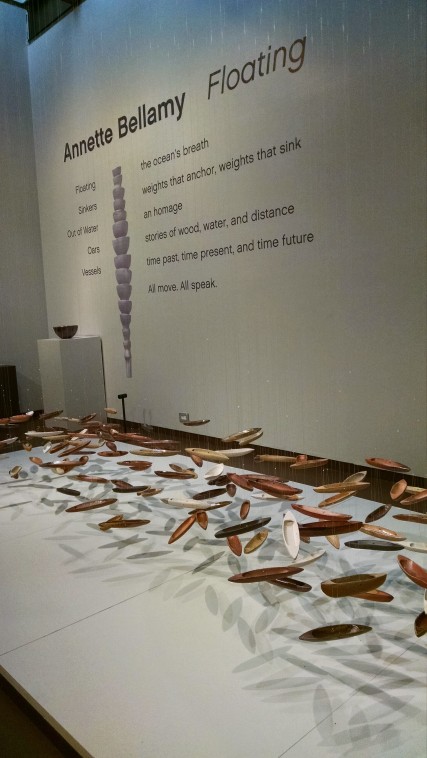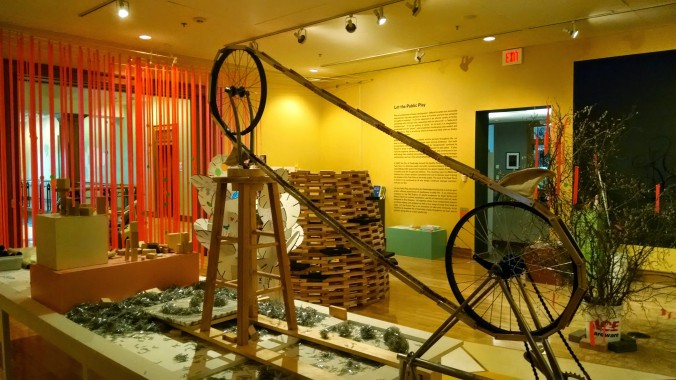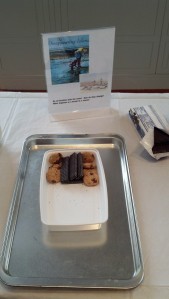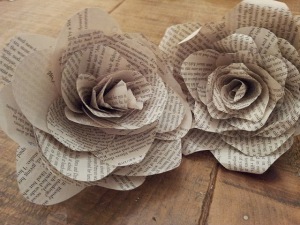A few months ago, the Center for the Future of Museums posted a challenge: what might preK-12 education look like in 2040 if museums got involved in new and more thorough ways than we do now? Instead of asking for statements or essays, they wanted stories: imagine the future, and tell us a good yarn.
So seventy-eight of us did. The winners’ stories are all fascinating, and I recommend you have a look here. I’m also pleased to be able to say that my entry won an honorable mention, and is posted on the “Vibrant Learning” microsite here. The lovely folks at CFM have granted me permission to post my story in its entirety here as well.
I picked the Harvard Museum of Natural History as my ‘future-awesome’ location because it was a place I spent a fair amount of time as an undergrad, but I’ve never worked there, so it’s a good balance of familiar but not overly so. (Plus they’ve done some really neat events encouraging artists and students to ‘hack the museum’ by creating interesting overlays, installations, and interventions, so I figured they’d be game.)

Heterodontosaurus, photo from the Harvard Museum of Natural History, Romer Hall
It Was Supposed to Be Dinosaurs
by Meg Winikates
Senator Ariel Kwan
1705 Russell Senate Office Building
Washington, DC
February 15, 2040
Dear Senator Kwan,
As your constituent, I write today to urge you to vote for the reauthorization and increased funding for the Family Learning Leave Act. I also thank you for your continued support of the Institute of Museums and Library Services, especially as it was museums and libraries who spearheaded the initial passage of the Act.
I hope that based on your previous record, you already intend to vote in favor, but I would like to share the lasting impact this bill has had on my family and so many families like mine. Enclosed you will find a selection from the learner’s self-assessment report I wrote during my daughter’s Kindergarten Collaborative three years ago, and an interview from my subsequent Artist’s Spotlight this past autumn. Were it not for Learning Leave, I would never have been able to take the time away from my retail job to support my daughter’s education. Having the opportunity to connect, to explore, and to create together has given me a better understanding of how she learns and what her options for the future are. Thanks to our museum experiences, my daughter is now in an accelerated Creative Science program, and I gained inspiration and contacts which have allowed me to grow my own independent business.
Thank you for your attention and support for this vital program.
Regards,
Hannah Lopez
Parent, Artist, Businesswoman, Museum Supporter
[encl.]
= = = = = = =
Harvard Museums of Science and Culture: Kindergarten Collaborative
Adult Learner’s Self-Assessment Journal, Day 3
Today was the best day yet of my ‘grown-ups go to school’ adventure. Lucy has, of course, spent the last two days beyond excited. She has been absolutely bubbling to show me all the places in the museums that she loves, and it’s been amazing to see how seriously she takes her job as a ‘guide’ for me, the museum newcomer. Today I really got to appreciate the way my shy baby has learned to work with the other children, and how responsive the education team is to their curiosity and enthusiasm. It’s clear they have some specific educational goals in mind, so it’s not the free-for-all that it would be if I tried to run a class of five- and six- year-olds, but with one adult for every four or five kids, the educators really do know how to listen and guide the conversation without cutting off or shutting down the little ones.
Today, for instance, was the start of ‘dinosaur days.’ I guess they’d spent some time in the dinosaur galleries before now, but mostly were exploring other things; rocks, I think, and teeth? Lucy will surely tell me in great detail if I ask. But today was dinosaurs, and the kids split themselves up into small groups, gravitating to a fossil, cast, sculpture, or diorama, already used to peppering the educator stationed nearby with questions, almost before the kids stopped moving.
Then the educators pulled out this spray-on-glove stuff, apparently the same kind that their conservators use in the lab, and spritzed all our hands and let us touch the fossils. The stuff’s so thin, you could feel every bump and grain, like the gloves weren’t there at all, but apparently it keeps all the sweat and oils from your hands off the delicate bits. Crazy, but just so cool. (I actually got up the guts to ask one of the educators later where the glove-spray came from, and she looked really proud of me. I guess they are serious about the grown-ups being there to learn too. Turns out it was first developed for medical work, which makes sense.)
So there we were, touching the fossils, and one of the kids in Lucy’s group asked how they found the fossils, which meant we all got to troop outside to the lawn to try out the ground penetrating radar machine. With five year olds. Looking for the ‘modern fossils’ in plaster that the museum had buried in the front lawn. Once we got *very* dirty uncovering them with shovels and trowels and measuring tapes, we then went at the plaster with real chisels, hammers, and brushes. I don’t know what that educator would have done if the kid hadn’t asked that question, but I hope she would have managed to get us out there eventually somehow, or some poor college student would’ve spent a whole afternoon of their work-study burying fake fossils for nothing. And all of that was before lunch time. I know some of the kids in Lucy’s group; they’re a hyper, easily distracted bunch of kids most of the time (especially right before lunch). But they were really engaged, and I admit as a mom it was awesome to see my normally quiet little girl take charge of an excavation. “No, Momma, you have to make a drawing before you pull it out of the ground!” and, “No, my momma should do the drawing because she’s an artist!”
Sweet, given that my drawing abilities are limited to making costume patterns, but it’s always nice to feel like you’re your kid’s hero.
After lunch it was back to the original room, this time to look at the Pteranodon. It’s hard to believe something encased in rock could ever fly, which I totally get, so Lucy and her buddies were understandably skeptical. Only Lucy and her pal Karen were completely unconvinced by the video of the scientists’ animated model, though, which means they were the ones that split off from the group to go into the PhysLab (“FizzFizzFizz, like ideas in your head, Momma, that’s why it’s called that!”) to test out wing designs.
We made wings of paper, string, and straws, and tested them in the wind tunnel. We each picked our favorite, put it in the scanner, and got to add the finished computer model to a digital animal body to animate and watch it ‘fly.’ Lucy was very serious about hers; she actually wanted to recreate the scientists’ Pteranodon for herself, but I admit I got a little silly with mine, and made a dragon.
I never was the science one in the family, after all.
I half-expected to get in trouble for not taking the ‘assignment’ seriously, but instead, it was like I’d made the PhysLab overseer’s day. She handed me an exhibit brochure for a fantastical creatures show at one of the other university museums, and when I told her that my side gig was fantasy costuming, I ended up with info on 3D printing wearables, a costume design exhibit announcement for a museum across town, and a shiny new Searcher ID card.
I’d heard there was some kind of library-card-for-museums thing, but between work and family and all, not the sort of thing I’ve had time to go looking for on my own. It’s fancier than the library card I had as a kid; you add some personal details to your profile, interests and stuff, and it gives you suggestions on where to go and who to talk to for answers. Plus it gets you in free if you’re working on a research project. So I could go see that costume design exhibit on research for my own designs, and talk to a curator or a designer, and borrow study materials, all on the strength of this card that I wouldn’t have if I hadn’t been messing around with dragon designs on the computer at the museum to make my daughter laugh.
So yeah, definitely the best day of my learning leave yet. I think I’m as excited as Lucy to go back to “school” tomorrow.
= = = = = = =
“Wings, Webs, and Wishes: An interview with Hannah Lopez” by Ginny Evans
Harvard Museums of Science and Culture newsletter
This month’s Artist Spotlight is costumer Hannah Lopez, who has been the brains and hands behind this spring’s highly anticipated Paleontology Parade performances. Lopez’s temporary home is HMSC’s PhysLab, where she was finishing printing the latest dinosaur-skull headpiece for enthusiastic decoration by her ‘apprentice’ — daughter Lucy, age 8.
When asked why she wanted to meet in the PhysLab, Lopez laughs.
“Because it pretty much started here, with designing dragon wings.” Behind her, Lucy scoffs into her glitter paint; it’s clear she’s been part of telling this story enough to say,
“Dinosaurs, mom, it was supposed to be dinosaurs.”
“Yes it was, but mine were dragons, and it was a good thing they were, too.” Lopez’s eyes light up as she talks about the chance encounter with fellow fantasy-fan and HMSC staff, Maya McCormack.
“She wouldn’t let me leave the lab until I’d finished my Searcher profile. Those first couple of resources she pointed me to, they were great for bringing my inspiration back. It’s so easy to get lost in the day to day details. But somewhere in there, in watching Lucy fall in love with science here at the museum, and in taking the time to follow up on the connections Maya made, getting close to those fabrics in the teaching collection, it made me want to do something big. Bigger than the kids’ Halloween costumes and Renaissance Faire garb I’d been doing in little bits. And once I had the bug, I just didn’t stop. If that Searcher card had been a credit card, I’d have reached my limit ages ago.” Lopez laughs.
“Lucky for me it doesn’t work that way. It’s like getting lost on the internet, but better, because it’s this whole web of people and things and ideas that you can reach in person, and some of the time it turns out they’re looking for you, too.”
The discussion turns to the binder of costume designs in front of us and the nearly-finished pieces on her worktable nearby, since it seems dinosaurs have won the day, at least this time.
“Getting the artist residency here, it felt like the right thing to do,” Lopez agrees. “I wanted to do something collaborative, something that showed what Lucy and I both learned when we were first here, and to keep that excitement going. So we’ve been having troops of kids of all ages in here to help with personalizing their costumes, and making comments on the designs for the professional actors. I think the final effect will be just on the right side of hilarious and brilliant.”
Opening next week, Paleontology Parades will be a series of theatrical skits that bring various stories in the museum to life, incorporating both professional actors and the schoolchildren they’ve been working with, including Lucy and her classmates in the Creative Science program. The acting troupe, the Wishing Wells, are another contact Lopez made through the Searcher program, when it recently expanded to include performing arts organizations.
“Working with Jason and the team from Wishing Wells has been a lot of fun. I can’t wait to put the last scales and feathers in place and watch it all light up.”
And what’s next for Lopez (and her apprentice)? They give identical grins.
“Well, to celebrate, we thought we’d go find a new museum to explore.”





























